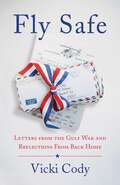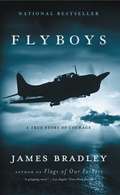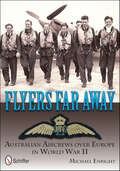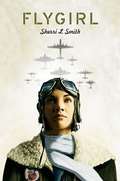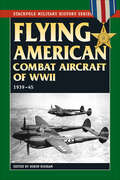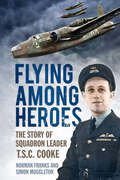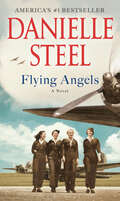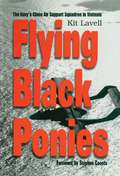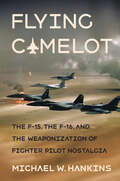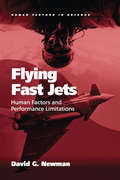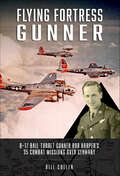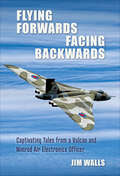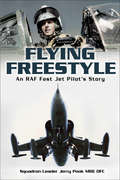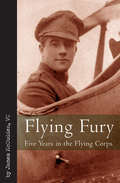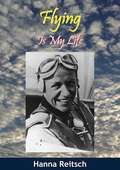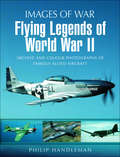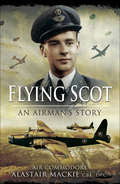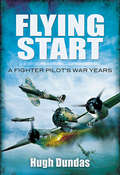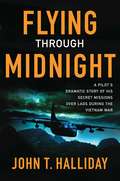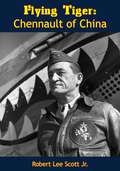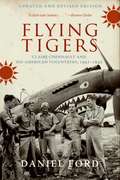- Table View
- List View
Fly Safe: Letters from the Gulf War and Reflections From Back Home
by Vicki CodyIt is August 1990, and Iraq has just invaded Kuwait, setting off a chain reaction of events leading up to the first Gulf War. Vicki Cody&’s husband, the commander of an elite Apache helicopter battalion, is deployed to Saudi Arabia—and for the next nine months they have to rely on written letters in order to stay connected.From Vicki&’s narrative and journal entries, the reader gets a very realistic glimpse of what it is like for the spouses and families back home during a war, in particular what it was like at a time when most people did not own a personal computer and there was no Internet—no iPhones, no texting, no tweeting, no Facetime. Her writing also illuminates the roller coaster of stress, loneliness, sleepless nights, humor, joys, and, eventually, resilience, that make up her life while her husband is away. Meanwhile, Dick&’s letters to her give the reader a front row seat to the unfolding of history, the adrenaline rush of flying helicopters in combat, his commitment to his country, and his devotion to his family back home. Together, these three components weave a clear, insightful, and intimate story of love and its power to sustain us.
Flyboys: A True Story of Courage
by James BradleyThis acclaimed bestseller brilliantly illuminates a hidden piece of World War II history as it tells the harrowing true story of nine American airmen shot down in the Pacific. One of them, George H. W. Bush, was miraculously rescued. The fate of the others--an explosive 60-year-old secret--is revealed for the first time in FLYBOYS.
Flyers Far Away: Australian Aircrews over Europe in World War II
by Michael EnrightFirst one-volume history covering Australian airmen in World War II
Flygirl
by Sherri L. SmithWhen America enters World War II, the Army creates the Women's Air Force Service Pilots (WASP). Having always dreamed of flying, Ida Mae Jones, a young African-American woman, suddenly sees a way to fly as well as do something significant to help her brother stationed in the Pacific.
Flying American Combat Aircraft of World War II: 1939–45 (Stackpole Military History Series)
by Robin HighamWWII fighter pilots share stories of flying into battle from Berlin to Tokyo in Mustangs, Spitfires, Flying Fortresses and more. In Flying American Combat Aircraft of World War II, U.S. Air Force veterans recount thrilling tales that put readers in the cockpit. These personal remembrances of aerial combat offer vividly detailed depictions of fighting across Europe as well as in the Pacific. The twenty-nine contributors also cover a wide range of America&’s WWII-era combat aircraft, including the B-25 Mitchell, B-29 Superfortress, P-47 Thunderbolt, P-40 Kittyhawk, B-18 bomber, and many others. Their stories are enhanced by dozens of photographs of the planes and the pilots who flew them.
Flying Among Heroes: The Story of Squadron Leader T.S.C. Cooke
by Norman Franks Simon MuggletonT.S.C. Cooke joined the RAF as war began in 1939, aged 18, and trained to be a bomber pilot. Rising to the rank of squadron leader and decorated three times, Cooke bombed Berlin on 7 October 1940 in a Whitley Mk V, nearly ditching in the North Sea. Throughout this tour he faced the usual dangers of wartime aircrew, his aircraft being hit by AA fire on several occasions, once almost having to order his aircrew to bail out but landed safely at the last minute. They were also attacked by night fighters, encountered icing and even shot up a train and bomber station at tree-top level. Flying Wellingtons and Stirlings, Cooke took part in the infamous 1,000-bomber raid on Cologne and Essen, before returning to operations flying Special Ops Halifax aircraft, dropping agents into enemy-occupied France. After a dozen missions, he was shot down but he and his navigator survived and evaded capture. Helped by the French resistance, they got into Spain and returned home via Gibraltar. Both men received the DFC for their bravery. While their story is not totally unique, their adventures and courage make this tale akin to an adventure novel.
Flying Angels: A Novel
by Danielle SteelWorld War II brings together six remarkable young flight nurses, who face the challenges of war and its many heartbreaks and victories as unsung heroes, in this inspiring novel from #1 New York Times bestselling author Danielle Steel. <P><P>Audrey Parker’s life changes forever when Pearl Harbor is attacked on December 7, 1941. Her brother, a talented young Navy pilot, had been stationed there, poised to fulfill their late father’s distinguished legacy. Fresh out of nursing school with a passion and a born gift for helping others, both Audrey and her friend Lizzie suddenly find their nation on the brink of war. <P><P>Driven to do whatever they can to serve, they enlist in the Army and embark on a new adventure as flight nurses. Risking their lives on perilous missions, they join the elite Medical Air Evacuation Transport Squadron and fly into enemy territory almost daily to rescue wounded soldiers from the battlefield. <P><P>Audrey and Lizzie make enormous sacrifices to save lives alongside an extraordinary group of nurses: Alex, who longs to make a difference in the world; Louise, a bright mind who faced racial prejudice growing up in the South; Pru, a selfless leader with a heart of gold; and Emma, whose confidence and grit push her to put everything on the line for her patients. <P><P>Even knowing they will not achieve any rank and will receive little pay for their efforts, the “Flying Angels” will give their all in the fight for freedom. They serve as bravely and tirelessly as the men they rescue on the front lines, in daring airlifts, and are eternally bound by their loyalty to one another. Danielle Steel presents a sweeping, stunning tribute to these incredibly courageous women, inspiring symbols of bravery and valor. <P><P><b>A New York Times Best Seller</b>
Flying Black Ponies
by Kit LavellThe tragic, the comic, the terrifying, the poignant are all part of the story of the Black Pony pilots who distinguished themselves in the Mekong Delta during the Vietnam War. Flying their turboprop Broncos down and dirty, low and slow, they killed more of the enemy and saved more allied lives with close-air support than all the other naval squadrons combined during the three years they saw action. Author Kit Lavell was part of this squadron of black sheep given a chance to make something of themselves flying these dangerous missions. The U.S. Navy's only land-based attack squadron, Light Attack Squadron Four (VAL-4) flew support missions for the counter insurgency forces, SEALs, and allied units in borrowed, propeller-driven OV-10s. For fixed-wing aircraft they were dangerous, unorthodox missions, a fact readers quickly come to appreciate.
Flying Camelot: The F-15, the F-16, and the Weaponization of Fighter Pilot Nostalgia (Battlegrounds: Cornell Studies in Military History)
by Michael W. HankinsFlying Camelot brings us back to the post-Vietnam era, when the US Air Force launched two new, state-of-the art fighter aircraft: the F-15 Eagle and the F-16 Fighting Falcon. It was an era when debates about aircraft superiority went public—and these were not uncontested discussions. Michael W. Hankins delves deep into the fighter pilot culture that gave rise to both designs, showing how a small but vocal group of pilots, engineers, and analysts in the Department of Defense weaponized their own culture to affect technological development and larger political change.The design and advancement of the F-15 and F-16 reflected this group's nostalgic desire to recapture the best of World War I air combat. Known as the "Fighter Mafia," and later growing into the media savvy political powerhouse "Reform Movement," it believed that American weapons systems were too complicated and expensive, and thus vulnerable. The group's leader was Colonel John Boyd, a contentious former fighter pilot heralded as a messianic figure by many in its ranks. He and his group advocated for a shift in focus from the multi-role interceptors the Air Force had designed in the early Cold War towards specialized air-to-air combat dogfighters. Their influence stretched beyond design and into larger politicized debates about US national security, debates that still resonate today. A biography of fighter pilot culture and the nostalgia that drove decision-making, Flying Camelot deftly engages both popular culture and archives to animate the movement that shook the foundations of the Pentagon and Congress.
Flying Colours (The Hornblower Saga, Book #3)
by C. S. ForesterIn Flying Colors, Captain Horatio Hornblower finds himself captured by the French and ordered executed by Napoleon Bonaparte himself. The unflappable Hornblower however plans a daring escape with the help of Lieutenant Bush and French Royalists.
Flying Fast Jets: Human Factors and Performance Limitations (Human Factors in Defence)
by David G. NewmanThis book provides a detailed general overview of the human factors and performance limitations associated with flying fast jets, integrating all the latest available research literature on the demanding operational tasks faced by such pilots and aircrews. As such, it has a strong military focus, dealing with pilots of fighter aircraft, attack aircraft and lead-in fighter trainer aircraft that are traditionally only single or dual pilot operations. The book deals not only with the issue of G force, but discusses ejection and escape/survival, disorientation, high altitude physiology, pilot training and selection, helmet-mounted equipment, situational awareness, data fusion and multi-sensor integration, human machine interface issues and advanced cockpit design. It examines the human performance issues associated with the technological advances made in fast jets, such as increased manoeuvrability, increased use of the pilot’s head as a mounting platform for sensor and weapons systems, and the complexities involved in the human-machine interface within these aircraft.
Flying Fortress Gunner: B-17 Ball Turret Gunner Bob Harper's 35 Combat Missions over Germany
by Bill CullenThe biography of Bob Harper, a B-17 ball turret gunner with the 8th Air Force who survived 35 combat missions over Germany in WWII, and was shot down twice. At 5 feet, 4 inches tall and weighing just 110 pounds, Bob Harper was below the minimum size requirements for US military service. As the demand for manpower increased, rules were bent, Harper’s deferment was retracted, and he was drafted into the Army. Harper was deployed to the European front and survived 35 combat missions as a B-17 ball turret gunner. Based at airfields in England, Bob and the 381st Bomb Group flew brutal missions over heavily defended industrial centers in Germany. Harper was shot down twice and awarded the Distinguished Flying Cross. Through his letters home, combat reports, and extensive interviews with author Bill Cullen, Harper describes his harrowing experiences on board the Flying Fortresses of the Eighth Air Force. Cullen’s interviews with Harper took place over a period of years, and it is the anecdotes from the interviews that drive the majority of the narrative. The ball turret was located underneath the aircraft and was a confined, intense, and unique environment from which to experience combat during the Second World War. Readers will find Harper, who went on to a successful business career after the war, to be an insightful, witty, and engaging storyteller.
Flying Fortress: The Illustrated Biography of the B-17s and the Men Who Flew Them
by Edward JablonskiRenowned throughout the world for its strength and destructiveness, the Flying Fortress was one of the greatest fighting airplanes of all time. In this comprehensively documented biography, Edward Jablonski tells the story of the Flying Fortress Boeing B-17, America’s legendary long-range bomber. From the B-17's near death in infancy to the emergence of its successor, the Superfortress, Flying Fortress captures the exhilarating career of the B-17 with thrilling accounts of the exploits of these planes and their pilots. In this unforgettable history, Jablonski details the Fortress’s role in the strategic and tactical issues of air war, and chronicles the B-17’s roles in famous raids including Regensburg, Marienburg, Munster, Schweinfurt, Dresden, and Berlin, along with its part in great battles, such as D-Day. Masterfully written, Flying Fortress is a classic in aviation literature with over 400 illustrations (many unpublished action photos) in addition to a section on the design of the Flying Fortress, which includes a number of detailed cutaway drawings. Approximately 60 pages from the Flying Fortress’s Piloting Manual are also featured herein. Find out why the Flying Fortress ultimately redefined the concept of war.
Flying Forwards, Facing Backwards: Captivating Tales from a Vulcan and Nimrod Air Electronics Operator
by Jim WallsSince he was a child in the 1950s watching Vampires and Meteors operating from RAF Turnhouse, Jim Walls wanted to fly aircraft, he just never envisaged that his flying career would be spent in the back seat as opposed to the front. Jim guides readers through his 40-year RAF career that started as a Boy Entrant at RAF Cosford, then as an air radar tradesman, before specializing as an air electronics operator (AEOp) in the Nimrod MR1, and later as an air electronics officer (AEO) who flew in Nimrod R1s and Vulcan B2s. With detailed insight into the world of radar, electronic countermeasures, and signals intelligence, Jim highlights the role they played in warfare for numerous operations during the Cold War as well as the Falklands campaign, First Gulf War, and Bosnian War. He also recalls the peacetime role of the Nimrod and Vulcan with stories from his time on 51, 120, and 617 Squadrons. As well as focusing on his career, Jim gives his viewpoint on matters such as Operation Black Buck and the reduced war-fighting capability of the Vulcan as it neared retirement. This fascinating book showcases the vital role that AEOs held and the importance of radar and electronic warfare in the fight against enemy forces. It is also a tribute to the much-loved Cold War icons, the Nimrod and the Vulcan. With photography throughout, mainly from the author’s personal collection, this book will appeal to Cold War enthusiasts and fans of the iconic jets of that era.
Flying Fox: Otto Fuchs: A German Aviator’s Story, 1917–1918
by Adam M. WaitUnique personal history of the Imperial German Air Service
Flying Freestyle: An RAF Fast Jet Pilot's Story
by Jerry PookA British Royal Air Force pilot recounts his 25-year career in the cockpit during the Cold War in this military memoir. During a twenty-five-year flying career in the RAF, Jerry Pook has flown Hunter Fighter/Ground Attack aircraft in the Gulf, Harriers in West Germany, the supersonic Starfighter with the Dutch Air Force, the Harrier in Belize, Central America and the Tornado bomber at the Tri-national Tornado Training Establishment where he trained German and Italian pilots and navigators. Jerry had a long relationship with the Harrier Fighter/Ground Attack vertical take-off aircraft. This he flew in West Germany at the height of the Cold War operating from Wildenrath and off-base operations with Field Wing operations based in the fields and woods of the German countryside. Jerry saw action during the Falklands War when based on HMS Hermes and flying one of the few RAF Harriers in the Ground Attack role in support of the troops fighting ashore. He then enjoyed flying the American-built Starfighter RF 104G during a three-year exchange tour with the Dutch Air Force—he describes the Starfighter as &“beautiful to fly, smooth and sophisticated, supremely fast and powerful—if you took liberties with it you knew it would kill you in an instant.&” After three years with No 1 (Fighter) Squadron and again flying the Harrier, he moved to the then new Tornado, flying in its bomber role. This he continued to fly operationally and in the instructional role for thirteen years until grounded from military flying for medical reasons.
Flying Fury: Five Years in the Royal Flying Corps (Vintage Aviation Library)
by James B. McCuddenThe day-to-day insights of a brilliantly daring World War I ace that only ends with his death at the age of 23 . . . James McCudden was an outstanding British fighter ace of World War I, whose daring exploits earned him a tremendous reputation and, ultimately, an untimely end. Here, in this unique and gripping firsthand account, he brings to life some of aviation history&’s most dramatic episodes in a memoir completed at the age of twenty-three, just days before his tragic death. During his time in France with the Royal Flying Corps from 1914 to 1918, McCudden rose from mechanic to pilot and flight commander. Following his first kill in September 1916, McCudden shot down a total of fifty-seven enemy planes, including a remarkable three in a single minute in January 1918. A dashing patrol leader, he combined courage, loyalty, and judgment, studying the habits and psychology of enemy pilots and stalking them with patience and tenacity. Written with modesty and frankness, yet acutely perceptive, Flying Fury is both a valuable insight into the world of early aviation and a powerful account of courage and survival above the mud and trenches of Flanders. Fighter ace James McCudden died in July 1918, after engine failure caused his plane to crash just four months before the end of World War I. His success as one of Britain&’s deadliest pilots earned him the Victoria Cross.
Flying Is My Life [Illustrated Edition]
by Hanna Reitsch Lawrence Roy WilsonIncludes the Aerial Warfare In Europe During World War II illustrations pack with over 200 maps, plans, and photos.Hanna Reitsch is unusual in being a feminine woman who was yet the equal of men in a dangerous male profession -- test-piloting new military aircraft. Her love of flying from childhood on, along with her superior intelligence, determination, and ability to withstand tremendous stresses, gave her the edge that allowed her to rise to the top of the aviation world.Hanna Reitsch offered her gifts to the German nation in the same way that Adolf Hitler and many others did -- with a complete giving of herself and her abilities, holding nothing back. Although she lived to 1979, she never renounced her participation with the National Socialist government or criticized Hitler, even under pressure to do so. Hanna's life story is an amazing one that sounds almost unbelievable in its drama and acts of heroism. She never married or had children; instead she occupied herself with the two burning loves of her life -- flying and the salvation of her beloved Fatherland in its time of need.
Flying Legends of World War II: Archive and Colour Photos of Famous Allied Aircraft (Images of War)
by Philip HandlemanMore than thirty Allied Forces' WWII aircraft types are illustrated in many rare and previously unpublished black and white and color photographs. Each type is described giving vital data on development history, combat record, famous pilots and significant air battles. Performance, range and weapon loads are also included. The unique color photographs are from the collection of the late William B. Slate, an aviation photographer who strove to capture the thrilling perspective that can only come from close-up, in-flight vantage points from an aircraft flying in formation.
Flying Scot: An Airman’s Story
by Alastair Mackie"This is the memoir of a 26 year career in the RAF, told with humor and modesty that belies the danger of flying over 47 different types of military aircraft in war and peace. Alastair Mackie began his operational career flying Wellington bombers over the North African desert war until converting to the B-24 Liberator. He watched the famous opening barrage at the opening of El Alamein from the air and became involved in supplying the besieged island of Malta together with hunting German ships in the Mediterranean. He was then posted to Northern Ireland converting to the DC-3. He flew during D-Day, dropping parachute troops into German held territory and continued these operations until the wars end when he was part of the operation to return British troops and released POWs to the UK. He was then posted to a long-range DC-3 squadron and flew to all points East.After the war he was posted to The Central Flying School teaching future flying instructors in a variety of aircraft from Tiger Moths to Lancasters. After a tour in the Far East where he flew his own personal Spitfire, he returned to the UK to convert to the jet aircraft then coming into service. After a spell desk bound on the Cabinet Office Joint Intelligence Committee, which he disliked, he was appointed Station Commander at Colerne which operated the Hastings transport aircraft. Alastair was then appointed wing commander in charge of flying at RAF Waddington. The job also gave him the charge of two resident Canberra bomber squadrons, Nos. 37 and 38. With them he was able to get plenty of flying in an aircraft he loved. After retiring from the RAF he commenced a career in Law and in his later years he has become a firm opponent of Britains nuclear deterrent, having seen its preparation with the Vulcan Force until the Royal Navy assumed the role it now has. "
Flying Start: A Fighter Pilot's War Years
by Hugh DundasThis is the autobiography of Group Captain Sir Hugh Dundas CBE, DSO, DFC, who was one of the most distinguished fighter pilots of World War II. He writes of his wartime experiences, and particularly of his period as Squadron Leader and Wing Commander and his involvement in the Battle of Britain.
Flying Through Midnight: A Pilot's Dramatic Story of His Secret Missions Over Laos During the Vietnam War
by John T. HallidayRiveting, novelistic, and startlingly candid, John T. Halliday's combat memoir begins in 1970, when Halliday has just landed in the middle of the Vietnam War, primed to begin his assignment with the 606th Special Operations Squadron. But there's a catch: He's stationed in a kind of no-man's-land. No one on his base flies with ID, patches, or rank. Even as Richard Nixon firmly denies reporters' charges that the United States has forces in Laos, Halliday realizes that from his base in Thailand, he will be flying top-secret, black-ops night missions over the Laotian Ho Chi Minh Trail. A naive yet thoughtful twenty-four-year-old, Halliday was utterly unprepared for the horrors of war. On his first mission, Halliday's C-123 aircraft dodges more than a thousand antiaircraft shells, and that is just the beginning. Nothing is as he expected -- not the operations, not the way his shell-shocked fellow pilots look and act, and certainly not the squadron's daredevil, seat-of-one's-pants approach to piloting. But before long, Halliday has become one of those seasoned and shell-shocked pilots, and finds himself in a desperate search for a way to elude certain death. Using frank, true-to-life dialogue, potent imagery, and classic 1970s song lyrics, Halliday deftly describes the fraught Laotian skies and re-creates his struggle to navigate the frustrating Air Force bureaucracy, the deprivations of a remote base far from home and his young wife, and his fight to preserve his sanity. The resulting nonfiction narrative vividly captures not only the intricate, distorted culture of war but also the essence of the Vietnam veteran's experience of this troubled era. A powerhouse fusion of pathos and humor, brutal realism and intimate reflection, Flying Through Midnight is a landmark contribution to war literature, revealing previously top-secret intelligence on the 606th's night missions. Fast-paced, thrilling, and bitingly intelligent, Halliday illuminates it all: the heart-pounding air battles, the close friendships, the crippling fear, and the astonishing final escape that made the telling of it possible.
Flying Through Midnight: A Pilot's Dramatic Story of His Secret Missions over Laos During the Vietnam War
by John T. HallidayRiveting, novelistic, and startlingly candid, John T. Halliday's combat memoir begins in 1970, when Halliday has just landed in the middle of the Vietnam War, primed to begin his assignment with the 606th Special Operations Squadron. But there's a catch: He's stationed in a kind of no-man's-land. No one on his base flies with ID, patches, or rank. Even as Richard Nixon firmly denies reporters' charges that the United States has forces in Laos, Halliday realizes that from his base in Thailand, he will be flying top-secret, black-ops night missions over the Laotian Ho Chi Minh Trail. A naive yet thoughtful twenty-four-year-old, Halliday was utterly unprepared for the horrors of war. On his first mission, Halliday's C-123 aircraft dodges more than a thousand antiaircraft shells, and that is just the beginning. Nothing is as he expected -- not the operations, not the way his shell-shocked fellow pilots look and act, and certainly not the squadron's daredevil, seat-of-one's-pants approach to piloting. But before long, Halliday has become one of those seasoned and shell-shocked pilots, and finds himself in a desperate search for a way to elude certain death. Using frank, true-to-life dialogue, potent imagery, and classic 1970s song lyrics, Halliday deftly describes the fraught Laotian skies and re-creates his struggle to navigate the frustrating Air Force bureaucracy, the deprivations of a remote base far from home and his young wife, and his fight to preserve his sanity. The resulting nonfiction narrative vividly captures not only the intricate, distorted culture of war but also the essence of the Vietnam veteran's experience of this troubled era. A powerhouse fusion of pathos and humor, brutal realism and intimate reflection, Flying Through Midnight is a landmark contribution to war literature, revealing previously top-secret intelligence on the 606th's night missions. Fast-paced, thrilling, and bitingly intelligent, Halliday illuminates it all: the heart-pounding air battles, the close friendships, the crippling fear, and the astonishing final escape that made the telling of it possible.
Flying Tiger: Chennault of China
by Robert Lee Scott Jr.Flying Tiger: Chennault of China by Robert Lee Scott, Jr. tells the story of a rebel whose concepts as to the use of air power often clashed with the orthodox and standardized teachings of the military schools of his time.
Flying Tigers
by Daniel FordDuring World War II, in the skies over Rangoon, Burma, a handful of American pilots met and bloodied the "Imperial Wild Eagles" of Japan and in turn won immortality as the Flying Tigers. One of America's most famous combat forces, the Tigers were recruited to defend beleaguered China for $600 a month and a bounty of $500 for each Japanese plane they shot down-fantastic money in an era when a Manhattan hotel room cost three dollars a night. To bring his prize-winning history of the American Volunteer Group up to date, Daniel Ford has completely rewritten his 1991 text, drawing on the most recent U.S., British, and Japanese scholarship. New material from AVG veterans-including Erik Shilling and Tex Hill-help fill out the story, along with newfound recollections from Japanese and New Zealand airmen. Ford also takes up the rumors that Royal Air Force pilots "sold" combat victories to the Flying Tigers in order to share in the bounties paid by the Chinese government. "Admirable," wrote Chennault biographer Martha Byrd of Ford's original text. "A readable book based on sound sources. Expect some surprises." Even more could that be said of this new and more complete edition.
